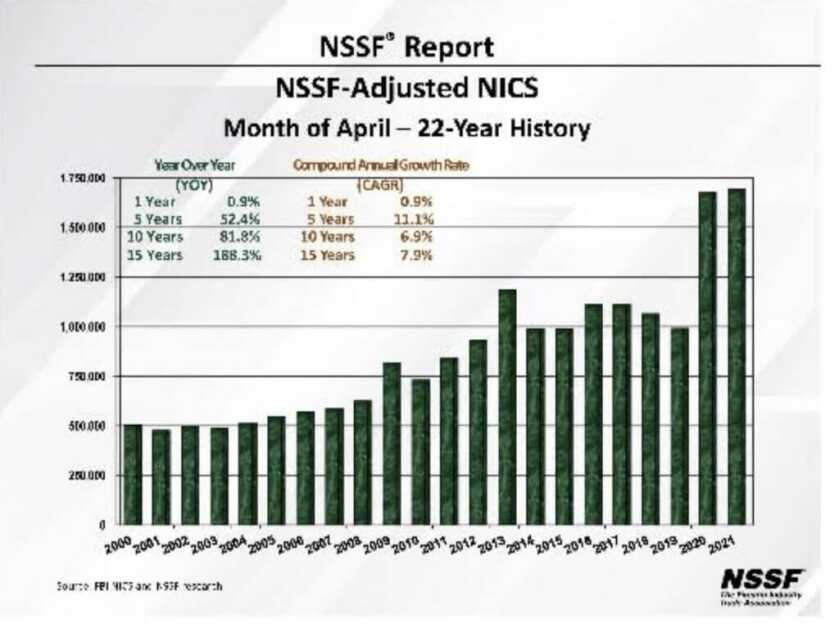
Newtown, CT — The April 2021 NSSF-adjusted National Instant Criminal Background Check System (NICS) figure of 1,694,118 is an increase of 0.9 percent compared to the April 2020 NSSF-adjusted NICS figure of 1,678,223. For comparison, the unadjusted April 2021 FBI NICS figure 3,485,016 reflects a 21.1 percent increase from the unadjusted FBI NICS figure of 2,878,176 in April 2020.
Please note: Twenty-five states currently have at least one qualified alternative permit, which under the Brady Act allows the permit-holder, who has undergone a background check to obtain the permit, to purchase a firearm from a licensed dealer without a separate additional background check for that transfer. The number of NICS checks in these states does not include these legal transfers based on qualifying permits and NSSF does not adjust for these transfers.
Recently, the states of Alabama and Michigan had law changes that affected their Brady Law standing which removed qualifying alternate permits usage for firearm transactions. These changes went into effect July 22, 2019 for Alabama, and March 3, 2020 forMichigan. In April 2020, Alabama state’s NSSF-adjusted NICS was 263.0 percent higher than April 2019, which accounts for an additional 35,564 checks over this time last year. April 2020 NICS numbers for Michigan were up 114.8% over April 2019 and account for an additional 21,862 checks.
SEE ALSO: New From Klik Belts and Black Collar Arms: The Klik Sling 2-Point Modular Quick Adjust Rifle Sling
The adjusted NICS data were derived by subtracting out NICS purpose code permit checks and permit rechecks used by states for CCW permit application checks as well as checks on active CCW permit databases. NSSF started subtracting permit rechecks in February 2016.
Though not a direct correlation to firearms sales, the NSSF-adjusted NICS data provide an additional picture of current market conditions. In addition to other purposes, NICS is used to check transactions for sales or transfers of new or used firearms.
It should be noted that these statistics represent the number of firearm background checks initiated through the NICS. They do not represent the number of firearms sold or sales dollars. Based on varying state laws, local market conditions and purchase scenarios, a one-to-one correlation cannot be made between a firearm background check and a firearm sale.
More from Mark Oliva, NSSF Director of Public Affairs:
NSSF’s Adjusted National Instant Criminal Background of nearly 1.7 million background checks in April was the strongest April on record and is on pace with the background checks that we’ve seen for more than a year. Background checks for firearm sales were nearly one percent higher than April 2020. Firearm sales remain elevated on two distinct concerns. Americans are buying firearms for concerns for personal safety and for White House and Congressional efforts to limit and deny the ability to purchase certain firearms. The continued gun control statements by President Biden, many of which have been fact-checked and debunked as false, are driving sales.
April marked 13 months of elevated firearm sales which have ranged between 1.5 million and 2 million each month. Firearm sales spiked in March 2020 and have remained at unprecedented levels since. It’s a remarkable feat of firearm manufacturers to keep pace with this blistering demand.
About NSSF
The National Shooting Sports Foundation is the trade association for the firearms industry. Its mission is to promote, protect and preserve hunting and the shooting sports. Formed in 1961, NSSF has a membership of thousands of manufacturers, distributors, firearms retailers, shooting ranges, sportsmen’s organizations and publishers nationwide. For more information, visit www.nssf.org.

When I was still selling firearms, the question of how many customers were using a carry permit instead of a NICS check to pass the 4473. The number was pretty consistently about a third, between 30 and 35 percent. Multiple purchases on a single background check were fairly uncommon, certainly fewer than 5% of 4473s involved multiple sales, so it would have been accurate to say that the number of firearms we were selling was about 50 to 60 percent more than the number of NICS checks we were running. That sort of statistic would not hold nationwide but I’d be comfortable estimating half to a third, so as a back of the envelope calculation, add maybe 20 to 25 percent to NICS checks for an estimate of the number of firearms purchased through FFL holders. That does not count firearms sold through the gun show loophole between private individuals where still allowed by state law but I would expect many fewer firearms selling between individuals in the last year; the used and second-hand markets of any collectibles has seen supplies dwindle and prices rise.